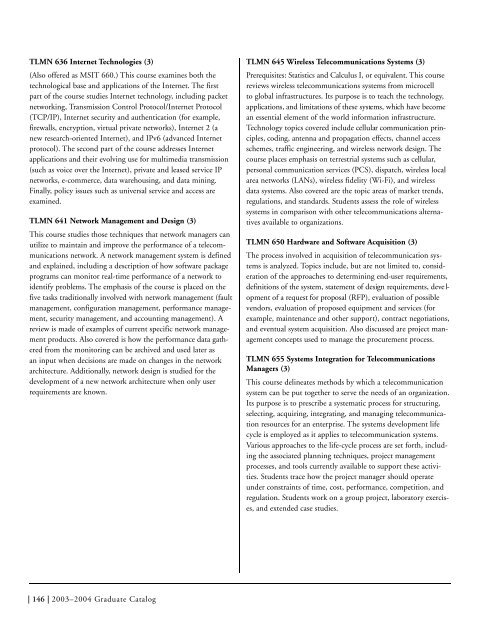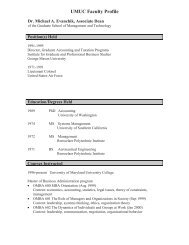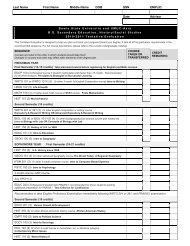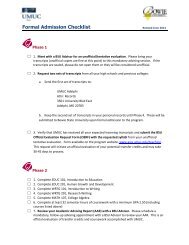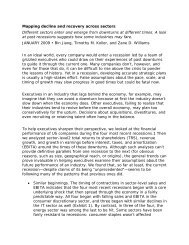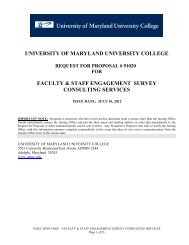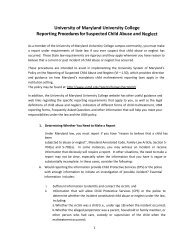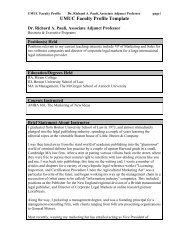A+B. Intro_SJ.1 - University of Maryland University College
A+B. Intro_SJ.1 - University of Maryland University College
A+B. Intro_SJ.1 - University of Maryland University College
Create successful ePaper yourself
Turn your PDF publications into a flip-book with our unique Google optimized e-Paper software.
TLMN 636 Internet Technologies (3)<br />
(Also <strong>of</strong>fered as MSIT 660.) This course examines both the<br />
technological base and applications <strong>of</strong> the Internet. The first<br />
part <strong>of</strong> the course studies Internet technology, including packet<br />
networking, Transmission Control Protocol/Internet Protocol<br />
(TCP/IP), Internet security and authentication (for example,<br />
firewalls, encryption, virtual private networks), Internet 2 (a<br />
new research-oriented Internet), and IPv6 (advanced Internet<br />
protocol). The second part <strong>of</strong> the course addresses Internet<br />
applications and their evolving use for multimedia transmission<br />
(such as voice over the Internet), private and leased service IP<br />
networks, e-commerce, data warehousing, and data mining.<br />
Finally, policy issues such as universal service and access are<br />
examined.<br />
TLMN 641 Network Management and Design (3)<br />
This course studies those techniques that network managers can<br />
utilize to maintain and improve the performance <strong>of</strong> a telecommunications<br />
network. A network management system is defined<br />
and explained, including a description <strong>of</strong> how s<strong>of</strong>tware package<br />
programs can monitor real-time performance <strong>of</strong> a network to<br />
identify problems. The emphasis <strong>of</strong> the course is placed on the<br />
five tasks traditionally involved with network management (fault<br />
management, configuration management, performance management,<br />
security management, and accounting management). A<br />
review is made <strong>of</strong> examples <strong>of</strong> current specific network management<br />
products. Also covered is how the performance data gathered<br />
from the monitoring can be archived and used later as<br />
an input when decisions are made on changes in the network<br />
architecture. Additionally, network design is studied for the<br />
development <strong>of</strong> a new network architecture when only user<br />
requirements are known.<br />
TLMN 645 Wireless Telecommunications Systems (3)<br />
Pre requisites: Statistics and Calculus I, or equivalent. This course<br />
reviews wireless telecommunications systems from microcell<br />
to global infrastructures. Its purpose is to teach the technology,<br />
applications, and limitations <strong>of</strong> these systems, which have become<br />
an essential element <strong>of</strong> the world information infrastructure.<br />
Technology topics covered include cellular communication principles,<br />
coding, antenna and propagation effects, channel access<br />
schemes, traffic engineering, and wireless network design. The<br />
course places emphasis on terrestrial systems such as cellular,<br />
personal communication services (PCS), dispatch, wireless local<br />
area networks (LANs), wireless fidelity (Wi-Fi), and wireless<br />
data systems. Also covered are the topic areas <strong>of</strong> market trends,<br />
regulations, and standards. Students assess the role <strong>of</strong> wireless<br />
systems in comparison with other telecommunications alternatives<br />
available to organizations.<br />
TLMN 650 Hardware and S<strong>of</strong>tware Acquisition (3)<br />
The process involved in acquisition <strong>of</strong> telecommunication systems<br />
is analyzed. Topics include, but are not limited to, consideration<br />
<strong>of</strong> the approaches to determining end-user re q u i re m e n t s ,<br />
definitions <strong>of</strong> the system, statement <strong>of</strong> design re q u i rements, deve l-<br />
opment <strong>of</strong> a request for proposal (RFP), evaluation <strong>of</strong> possible<br />
vendors, evaluation <strong>of</strong> proposed equipment and services (for<br />
example, maintenance and other support), contract negotiations,<br />
and eventual system acquisition. Also discussed are project management<br />
concepts used to manage the procurement process.<br />
TLMN 655 Systems Integration for Telecommunications<br />
Managers (3)<br />
This course delineates methods by which a telecommunication<br />
system can be put together to serve the needs <strong>of</strong> an organization.<br />
Its purpose is to prescribe a systematic process for structuring,<br />
selecting, acquiring, integrating, and managing telecommunication<br />
resources for an enterprise. The systems development life<br />
cycle is employed as it applies to telecommunication systems.<br />
Various approaches to the life-cycle process are set forth, including<br />
the associated planning techniques, project management<br />
processes, and tools currently available to support these activities.<br />
Students trace how the project manager should operate<br />
under constraints <strong>of</strong> time, cost, performance, competition, and<br />
regulation. Students work on a group project, laboratory exercises,<br />
and extended case studies.<br />
| 146 | 2003–2004 Graduate Catalog


